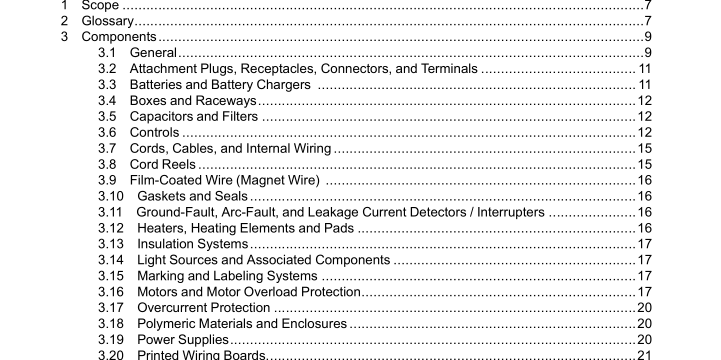UL 1431-2020 pdf download.Personal Hygiene and Health Care Appliances.
2.11 CONTROL, MANUAL – A device that requires direct human interaction to activate or rest the control. 2.12 CONTROL, OPERATING – A device or assembly of devices, the operation of which starts or regulates the end product during normal operation. For example, a thermostat, the failure of which a thermal cutout/limiter or another layer of protection would mitigate the potential hazard, is considered an operating control. Operating controls are also referred to as “regulating controls”. 2.13 CONTROL, PROTECTIVE – A device or assembly of devices, the operation of which is intended to reduce the risk of electric shock, fire or injury to persons during normal and reasonably anticipated abnormal operation of the appliance. For example, a thermal cutout/limiter, or any other control/circuit relied upon for normal and abnormal conditions, is considered a protective control. Protective controls are also referred to as “limiting controls” and “safety controls”. Note – During the evaluation of the protective control / circuit, the protective functions are verified under normal and single-fault conditions of the control. 2.14 CONTROL, TYPE 1 ACTION – The actuation of an automatic control for which the manufacturing deviation and the drift (tolerance before and after certain conditions) of its operating value, operating time, or operating sequence has not been declared and tested under this standard. 2.15 CONTROL, TYPE 2 ACTION – The actuation of an automatic control for which the manufacturing deviation and the drift (tolerance before and after certain conditions) of its operating value, operating time, or operating sequence have been declared and tested under this standard. 2.16 DOUBLE INSULATION – An insulation system comprised of basic insulation and supplementary insulation, with the two insulations physically separated and so arranged that they are not simultaneously subjected to the same deteriorating influences (temperature, contaminants, and the like) to the same degree. See 2.6, 2.25, and 2.28.
2.23 LOW VOLTAGE CIRCUIT – A circuit involving an open circuit potential of not more than 42.4 V peak (the peak voltage of a 30-V sine wave) supplied by a primary battery, by a standard Class 2 transformer, or by a combination of a transformer and fixed impedance that, as a unit, complies with all performance requirements for Class 2 transformers. 2.24 OPERATOR (USER) SERVICING – Any form of servicing that might be performed by personnel other than qualified service personnel. Some examples are: a) The attachment of accessories by means of attachment plugs and receptacles or by means of other separable connectors not involving disassembly or use of tools. b) Resetting of circuit breakers or replacement of fuses, and lamps that are accessible without the use of tools. c) Routine operating adjustments necessary to adapt the product for its different intended functions. d) Routine cleaning and changing of filters. 2.25 REINFORCED INSULATION – Improved basic insulation with such mechanical and electrical qualities that it, in itself, provides the same degree of protection against electric shock as double insulation. 2.26 SAFETY CIRCUIT – Any circuit, either in the primary or secondary, that is relied upon to reduce the risk of fire, electric shock, or unintentional contact with moving parts, for example, an interlock circuit is considered to be a safety circuit. 2.27 SECONDARY CIRCUITS – Secondary circuits are those circuits supplied from transformer output windings that are electrically separated from the input windings. 2.28 SUPPLEMENTARY (PROTECTING) INSULATION – An independent insulation provided in addition to the basic insulation to protect against electrical shock in case of mechanical rupture or electrical breakdown of the basic insulation.
3.1.2 A component of a product covered by this standard is not required to comply with a specific component requirement that: a) Involves a feature or characteristic not required in the application of the component in the product, b) Is superseded by a requirement in this standard, or c) Is separately investigated when forming part of another component, provided the component is used within its established ratings and limitations. 3.1.3 A component complying with a UL component standard other than those cited in 3.2 – 3.26 is acceptable if: a) The component also complies with the applicable component standard of 3.2 – 3.26; or b) The component standard: 3.1.4 A component that is also intended to perform other functions, such as over current protection, ground-fault circuit-interruption, surge suppression, any other similar functions, or any combination thereof, shall comply additionally with the requirements of the applicable UL standard(s) that cover devices that provide those functions. Exception: Where these other functions are not required for the application and not identified as part of markings, instructions, or packaging for the appliance, the additional component standard(s) need not be applied.UL 1431-2020 pdf download.
UL 1431-2020 pdf download
